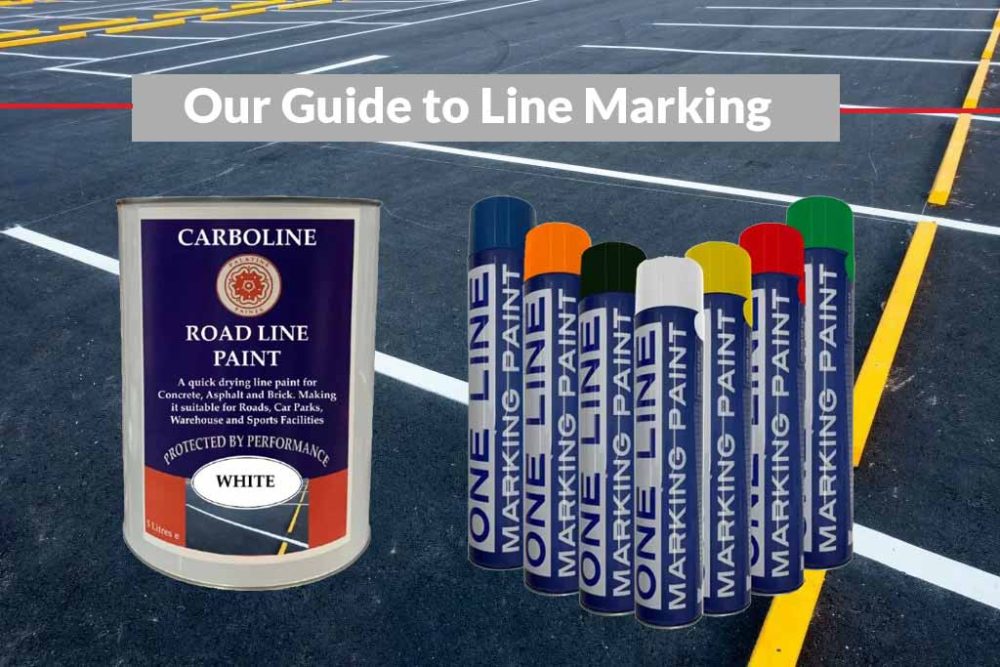All Blogs, Colour, Health and Safety
Our Guide to Line Marking
Knowing the correct ways to line your roads is important
Line marking activity can produce hilarious and more seriously, costly or dangerous results with use of the wrong product or poor application. So if you don’t want to see your own examples of thin, patchy or even ‘wonky’ lines adorning social media read on.
Why does it matter?
Sometimes it doesn’t matter if lines aren’t quite straight or in the correct place but in most situations, it’s vitally important to get it right.
From a health and safety point of view all organisations (from businesses to charities) must ensure the health and safety of employees, contractors, customers and visitors while on their premises. Route markings, pedestrian walkways, stopping and loading areas are just a few areas where well marked out, clearly visible line markings have an impact on safety.
What does the Health and Safety Executive say?
The HSE has produced several guides with recommendations and points. We’ve highlighted just a few the requirements you should be aware of:
Design and Layout
Good design and layout can help reduce accidents, including those involving vehicles and people slipping and tripping. When thinking about design and layout, consider the following areas: storage areas, aisles and gangways; pedestrian traffic routes; staircases and ramps and emergency escape routes.
Storage areas, aisles, traffic routes and gangways should be clearly marked out on the floor
Protecting pedestrians
“It is imperative that you take steps to minimise the associated risks…Define, designate and clearly mark pedestrian routes and crossing places. Support columns, pipework or other plant, should be identified, protected and clearly marked by black and yellow diagonal stripes. The edges of loading bays should be clearly marked in a similar way”
Health and Safety Executive Warehousing and storage A guide to health and safety

One Way Systems
HSE advises one way systems as a way to prevent accidents caused by reversing and conflict of vehicle movements.
Routes need to be clearly marked out using road markings and signs so that drivers can follow them easily. Road markings should be used to show, for example, traffic lanes, route edges, priority at junctions, stop lines, no-parking areas and pedestrian crossings. They should also be used to instruct drivers, for example ‘SLOW’. White road markings are used to regulate traffic and yellow markings are used to regulate parking.
“Faded markings should be replaced when they are no longer effective”
A guide to workplace transport safety
Parking and Pedestrians
The guide advocates the provision of safe and suitable parking areas and that where possible work-related vehicles are parked separately from parking spaces allocated to private cars, motorcycles and bicycles. Where pedestrians have to cross potentially hazardous work areas or traffic routes then physical precautions should be in place. Bollards, barriers and road markings can all contribute to this. Cross hatching entrance /exit areas to prevent parking obstructions can also help avoid queues, accidents and enable easy access for emergency vehicles.
“All signs and markings should be well maintained so they are visible at all times”
Line marking tips
Line marking, in most cases has to be durable, visible and accurate whether it’s on a games pitch or highlighting a safe route, so it’s important to get it right.
A few things to consider before going ahead:
- Area size – large or minimal
- Surface type – textured or smooth
- Location – external or internal
- Time – temporary or permanent
- Durability – traffic levels and reapplication periods
Planning your line marking project
Here’s a brief overview of how to prepare for your project and help choosing an appropriate line marker.
- Plan your layout
First draw out your layout to scale (if you have CAD software you can quickly adapt and change the plans easily). If necessary and feasible, chalk out the area to ensure the layout works sufficiently well to allow room for manoeuvring vehicles, doors opening etc.
If you’re really new to this, do some research into colours. Colours and layouts for sports pitches can be found at Sport England, for general use and safety, the colours are shown below:
- Which colours to use?
Here’s a guide to the generally accepted colour uses in terms of safety:
Yellow – Proceed with caution, used for aisles, walkways and traffic lanes (or cross hatching at junctions)
Red – Signals advice to stop before proceeding – or a no go area
White – display areas, floor stand displays, work areas
Blue – Information/materials/components and work in progress spaces
Green – Safety/first aid or emergency exit routes
Black/Yellow diagonal – Marks physical health or hazard zone
White stripes/chevrons – keep area clear
Select an appropriate time to line mark
Prepare a time in advance to undertake the line marking work i.e when no one else is around. The last thing you need is a line blurred because of someone’s footprint. Or worse, a customer complaining about paint stains on their footwear.
Choosing a line marking paint
Some specialist water based polyurethane line paints are ideal for sports hall/indoor court lines especially where multiple coloured lines intersect. A line marking machine achieves good results and specialist contractors generally undertake this kind of project
For most circumstances such as in warehouses, factories, workshops, car parks etc a good quality acrylic line marking spray is usually a good choice. Hard wearing and fast drying, these are easy to use on most surfaces and are suited to exterior and interior use. Small areas can be marked by hand but applicators are available in two wheeled and 4 wheeled options. The aerosols just slot into the applicator – they generally make the job of line marking much easier and are well worth investing in if you need to line mark more than a couple of times.
A road line marking paint is a good cost effective solution for industrial internal and external applications such as yard areas, car parks and walkways. Ours is a solvent borne durable line marking paint developed for industrial applications which can be applied by spray, brush or roller and is most suited to tarmac and concrete. With a semi-gloss finish, we can provide this in shades from the Ral Classic, BS 4800 or BS 381c range. It’s also available in 3 stock shades, Black, White and Yellow.
Always check data sheets to ensure the product you choose is the correct one for the job before proceeding.
Line marking spray ideal for tennis courts
What Width Should Lines be?
If you are painting on a public highway you will need permission from your local authority where they will also advise on standards. However it is also useful to apply generally accepted widths wherever lines are being painted for directional and safety purposes. These are as follows:
- – 50mm – dashed lines indicating parking spaces
- – 100mm – lines indicating parking space separation
- – 100mm – double yellow lines
- – 100mm – hatched areas
- – 150mm – lines indication lorry parking and cycle lane delineation
- – 200mm – lines showing priority (at junctions for instance)
- – 200mm – loading bay marking
- Lines and colours for sports pitches are generally as follows (but check the link to Sport England mentioned above for clarification )
- – 40mm – Badminton
- – 50mm – Netball (red), Basketball (black), Hockey (blue), Tennis (yellow), Volleyball (green)
- – 80mm – 5 a side football etc
Painting a White Line Across a Driveway
You may have noticed white lines across dropped kerbs in front of driveways to both business and residential properties.
These are generally aimed at preventing vehicles parking there and obstructing access. Can you just grab your white line spray and create one for yourself? The answer is ‘no’, there are strict rules about painting white lines or “H markings” outside your property. In most areas of the UK it is illegal to park across a dropped kerb and a white line can help to deter drivers from doing so.
If you have an access/dropped kerb and feel you need a white line painted, you must contact your local council’s highways department for permission. They will usually perform the job to the relevant highway standards and charge you for this. Further information can by found at Safer Motoring
How to Apply Line Marking Paint
There are various methods available to help apply line marking paint effectively and to get lines straight. For larger areas especially where you want to avoid bending, a line marking applicator is useful; this is a wheeled applicator which produces clear and precise lines.
A line marking aerosol spray is positioned into the applicator and is dispensed by pressing the applicator trigger. If you’re not using an applicator but are still using an aerosol, mask off two parallel lines using a spirit level and masking tape, then spray in smooth, consistent strokes.
Note that you will also need to cover surrounding areas to avoid over spray.
If you are using paint rather than aerosol, the easiest way to apply is to follow the same principle with tape and a spirit level then apply with a mini (4″) roller. Stencils are also available to help with lines and lettering, please contact us here at Palatine Paints with specific requirements as these are not always shown on our website.
Quick links to products mentions in this blog:
Acrylic Line Marker Spray 750ml
Road Line Marking Paint 2.5L | 5L
Mini Roller Sleeves 4″ (solvent resistant)
We hope this information has helped you and as always if you need more information try our online chat, leave a comment or give us call!
Contacting us is easy!
Email: [email protected]
Call Us: 01942 884 122
Contact form: https://www.palatinepaints.co.uk/contact-us
Live Chat Service: Press the small blue icon at the bottom left of your screen.

